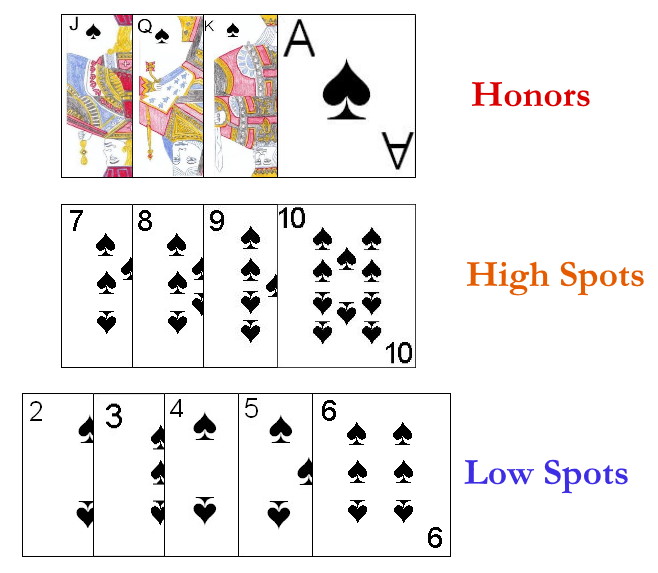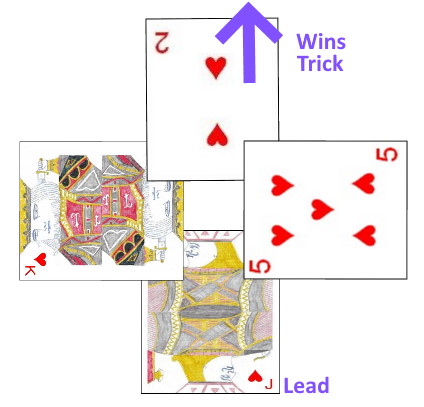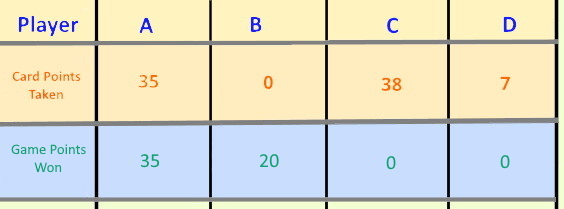How to Play Ambition
The card game Ambition is a fun trick-taking card game designed by game creator Mike Church. Mike first published the game in 2003, however since that time he has spent hundreds of hours refining and perfecting the game, with the result being a great strategical game in which almost any hand can be a winner.Notice: The rules for the card game Ambition are copyrighted by Mike Church (michael.o.church@gmail.com) © 2003 to 2021. The game has been included here with specific permission from the game's author.
 |
| Each of the cards in the game Ambition is a member of a specific card ranking group; Honors, High Spots, or Low Spots, shown here in the suit of Spades. |
For point scoring and other purposes the cards in the deck are divided into three special groupings. All cards of rank Ace, King, Queen and Jack are called honors, the cards in the rankings of 10, 9, 8, 7 are called high spots and all remaining cards (6, 5, 4, 3, 2) are called low spots.
Determination of seating positions and first dealer can be performed using a variety of methods, with draw for high cards commonly used. In that method, each player would draw a card from the face-down, shuffled deck. Any players drawing cards of the same rank would discard those and re-draw, and if drawing a card previously drawn by another player would draw again, continuing until each player has a card of a unique rank. The players would then seat themselves at the table in the order of cards drawn from highest to lowest. The player drawing the highest ranked card is also set as the first dealer. After each hand, the role of dealer should rotate in a clockwise direction around the table.
Once the players are seated and the dealer determined, this player should then thoroughly shuffle the deck and offer it to the player at his right to cut. After the cut, the dealer then begins dealing the cards around the table in a clockwise direction, starting with the player at his left. He deals the cards one by one and face down around the table, continuing until the entire deck has been dealt out which should leave each player with 13 cards.
After the cards have been dealt the players should then pick up his hand for examination. The player should then select three cards from his hand for a round of passing. on the first hand, each player will select three cards to pass to the player directly at his right. On the second hand, each player will similarly pass three cards to the player directly at his right. On the third hand, each player will pass three cards from his hand to the player directly across from himself at the table. On the fourth hand, the player will pass one card to each opponent. All cards should be passed face-down so other players do not see the identity of the card, and the passing player may select any of the cards initially dealt to him to pass. The player should not pick up the cards passed to him until he has first selected and passed the three cards he also intends to pass to the appropriate player or players.
 |
| If the two of the same suit as led to a trick is played in which an honor of that same suit is played, the two will always win that trick. |
Special role of the Two: It should be noted in this game that the two plays a special role. In whatever suit is led to any trick, the two of that suit automatically wins that trick, but only if that trick contains any honor card (Ace, King, Queen or Jack) from that same suit. If no honor cards are played to that trick, the two retains it's normal ranking under the three.
The winner of this first trick earns points for the cards captured in the trick (see below) as well as leads the first card to the next trick. After the first trick, the cards are played to the trick in the normal manner, with the leader first leading any card of his choice face-up to start the trick, and each other player, in a clockwise rotation around the table playing one card face-up to the trick from his hand. If a player has a card of the same suit as that led to the trick he must play it. If he has no such card, he may play any card from his hand to the trick. The highest card led to the trick wins the trick, with the special rule for twos enforced. Cards won are placed face-down out of play once it is determined who has won the trick and appropriate points are scored for it.
For purposes of scoring card points during the hand, each card in the deck has a unique value based on it's rank and suit. The following chart shows the value of each card in the deck:
| Suit | Card Rank | Point Value |
|---|---|---|
| Diamonds (♦) | Jack, Queen, King, Ace (Honors) | 3 Points Each |
| 7, 8, 9, 10 (High Spots) | 1 Point Each | |
| 2, 3, 4, 5, 6 | 0 | |
| Hearts (♥) | Jack, Queen, King, Ace (Honors) | 3 Points Each |
| 7, 8, 9, 10 (High Spots) | 1 Point Each | |
| 2, 3, 4, 5, 6 | 0 | |
| Spades (♠) | Jack, Queen, King, Ace (Honors) | 5 Points Each |
| 7, 8, 9, 10 (High Spots) | 3 Points Each | |
| 2, 3, 4, 5, 6 | 0 | |
| Clubs (♣) | King | 13 Points |
| 2, 3, 4, 5, 6, 7, 8, 9, 10, Jack, Queen, Ace | 0 | |
| Any | Winning the first trick | 3 Points |
To help record the card points won during the hand, after each trick, the winner of that trick will take a value in chips from the central pile equivalent to the number of points won in that trick (if any).
After the last trick has been played and won, the scoring for the hand can occur, in which points captured during the hand may translate to game points. The scoring schema as used in the game of Ambition is one of many unique features of this game. The following shows the final tally of scores players may earn at the end of each hand:
 |
| Example of the possible scoring in one hand of the game Ambition. |
- If one player manages to collect 51 or more total points during the hand (a slam) that player earns 40 game points for the hand and each opponent scores 0.
- However, if no player manages to earn a slam, the following are the possible scores each player can earn for that hand:
- If exactly one player manages to take 0 tricks during the hand, that player earns 20 game points
- If exactly two players manage to win 0 tricks during the hand, each of those players earns 10 game points.
- If a player takes one or more tricks, but earns fewer than 10 card points during the hand, that player earns 0 points for the hand (called an understrike).
- If a player manages to take 10 or more card points during the hand, but that player did not take the most points during the game, that player earns a number of points equal to the number of card points taken during that hand.
- The player or players (if there is a tie) taking the most points during the hand (except in the event of a slam) earns 0 points during the hand.
If no player has reached or exceeded 100 points, another hand is then played, after each player replaces the chips representing the points earned from the last hand, back into the common pool of such chips for the next hand.